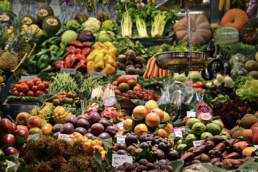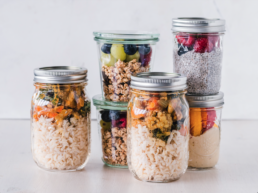By Jenny Fowler, First Mile Care DPP Coach
The First Mile Care Diabetes Prevention Program (DPP) teaches participants to make small adjustments in habits that add up to sustainable, healthy lifestyle change in eating, activity, sleep, and stress management.
While the DPP does not label foods or behaviors as “good” or “bad,” we recommend eating a diet high in fruits and vegetables. The ideal balance of a meal is about 50% produce, 25% starches and fibers, and 25% protein. It’s also essential to include some fats in the form of nuts, seeds, avocados, coconut oil, and olive oils, as they help you to feel satisfied.
Throughout the year-long DPP course developed by the Centers for Disease Control (CDC), we encourage participants to try new recipes, explore restaurants, and discover new ways to prepare food. In fact, one of the benefits of the First Mile Care DPP is our emphasis on sharing neighborhood-centric information with other participants in the group, who all live in the same ZIP codes as their coach.
A diet focused on produce doesn’t have to be simple or plain. Most Asian cuisines emphasize vegetables, yet their combinations of herbs and spices make for interesting flavor profiles. Experimenting with herbs and spices can jazz up your meal and even your beverages.
What’s the difference?
The dictionary definition distinguishing herbs from spices is that herbs are leafy things (e.g., basil, tarragon, thyme, cilantro, etc.) and spices are whole or ground seeds (e.g., coriander, cumin, anise etc.). But the division between leaves and seeds can be a bit messy.
Quite a few spices, like cardamom, cumin, and tumeric, come from plants that are botanically herbs — seed-producing plants that die down at the end of a growing season. Ginger (from a root) and garlic (a bulb) can generally be found in the spice aisle when in their powdered form, as can saffron (from a flower stigma) and clove (from a flower bud) which, like cinnamon bark, comes from a tree. And in the case of a number of plants, both leaves and seeds are used in culinary creations. The main thing is that, whatever their origin, they all add variety to the taste of your cooking.
Whether it’s an herb or a spice or simply something everyone thinks of as a spice, it’s important to remember that freshness really, really matters. People often say they don’t like a spice or don’t see its value, but that’s because they’ve tasted old dried stuff that sat in a kitchen cabinet for years.
When organizing your spice cabinet, keep these tips in mind:
- Write the purchase date on the jar cap or put a label on the bag. In this way, you’ll keep track of the age and know exactly how long that paprika has been on the shelf.
- Ground spices lose flavor more quickly than whole spices. As a general rule, whole spices can last up to four years, ground spices up to three years, dried herbs three years, spice blends two years, and fresh spices only a week or so. While it’s more convenient to buy them pre-ground, you’ll get more flavor over a longer period, and more benefits from the essential oils, if you buy them whole and grind them as you use them — similar to coffee beans.
- Before using any spice or herb in a jar, take a deep whiff. The sell-by date is not enough for judging freshness. If the aroma isn’t pungent, the taste (and health benefits) won’t be, either. Time to toss it.
Here are just a few herbs and spices that I like to use in meals. You can also experiment with infusing fresh herbs like basil and lavender in water for a tasty, sugar-free drink.
Herbs
Basil/mint. Many of the most popular culinary herbs are from the same mint family: anise hyssop, basil, lavender, lemon balm, oregano, rosemary, sage, savory, summer savory, sweet marjoram, and thyme. Basil contains antioxidants, vitamins and minerals, including vitamin A, vitamin K, iron, manganese, and calcium. Fresh or cooked basil is a delicious addition to salads and pasta dishes, and can even be a substitution for mint in a cocktail like a mojito.
Dill. The leaves of dill weed can be added like parsley to potato salad, tzatziki dip, and fish. The seeds are used as a spice to flavor foods like bread and pickles.
Lavender. Another member of the mint family, all lavender is edible, but some types have a higher camphor content so are better suited to soaps and bath products. What’s labeled as “culinary” lavender is a flavorful addition to vinegars, fruit, salads, and poultry dishes. Steep the seeds with black or herbal teas, or add them to ground coffee beans for an extra-soothing cuppa joe.
Lemon grass. Its distinct citrusy flavor and aroma is a staple in South Asian cooking. It’s widely used in savory dishes and meat, poultry, seafood, and vegetable curries, especially when combined with coconut milk. The stems are also used in teas, pickles, and in flavoring marinades. It promotes digestion and is considered a diuretic.
Oregano. As a member of the mint family, oregano has a minty aroma as well as a peppery bite and can even dress up canned soup. It often appears in Mexican and Spanish dishes as it pairs well with tomatoes, pasta, and olive oil. Oregano has antibacterial properties and has been shown to have antiviral properties for certain viruses. You can get therapeutic amounts from oregano oil.
Rosemary. The rosmarinic acid in this herb is known to help with allergies, nasal congestion, and overall inflammation. Fresh or dried rosemary will flavor oils, vinegars, sauces, meats, soups, and stews.
Sage. Sage is very high in vitamin K, and it contains vital minerals like magnesium, zinc, and copper.
This herb is antimicrobial which may help reduce dental plaque from bacteria in your mouth. Several types of acidic compounds in it act as antioxidants, which has made it a popular traditional ingredient in bedtime infusions.
Tarragon. This aromatic, licorice-scented herb is frequently used in French cuisine as it adds flavor to any meat or vegetable dish as well as soups. You can make your own salad dressings and meat marinades by infusing vinegar with tarragon. It’s a source of vitamins A, B6, and C, and is considered a digestive aid.
Spices
Cardamom. The black and green pods and seeds are widely used in Indian, Middle Eastern and even Swedish cuisine. It’s a core ingredient of popular masala spice mixtures that season meat and vegetable dishes, baked goods, and even chai tea, coffee, mulled wine, hot cider, and eggnog. It has a range of antioxidant, diuretic, and digestive properties that make it a fixture in traditional medicine.
Cayenne Pepper. A dash of this spice adds flavor to soups, stews, scrambled eggs, and hummus. It adds heat to Mexican sauces, Asian curries, and Cajun dishes. A tiny pinch gives a kick to hot cocoa or even lemonade. It offers potential health benefits as an active ingredient is capsaicin, which is thermogenic, meaning it speeds up metabolism. Like other chili peppers, cayenne peppers are especially rich in provitamin A carotenoids and vitamin C.
Cinnamon. Obtained from the inner bark of the cinnamon tree, cinnamon adds flavor not only to candy, pastries, breakfast cereals, and snack foods, but to savory dishes, fruit, and tea as well. It has antioxidant, antibiotic, and anti-inflammatory properties.
Coriander/Cilantro. The seeds of the coriander plant are the coriander spice, while in the U.S. we call its edible plant leaves and stems “cilantro.” It’s a member of the parsley family, related to other lacy-leaved plants such as anise, caraway, chervil, cumin, dill, and fennel, and even vegetables such as carrots, celery, and parsnips. Coriander leaves and seeds are full of vitamin K, and it also acts as a diuretic. The seeds can be roasted, pounded, and included in meat rubs and marinades.
Cumin. A spice from the dried seed of a plant in the parsley family, it’s a staple in spice blends and is used in Mexican, Indian, African, and Asian cuisines. It has calcium, iron, and magnesium, and also contains antioxidants which may be linked to benefits such as promoting digestion.
Paprika. This spice made from dried and ground red peppers is a common ingredient in spice blends and rubs, marinades, sauces, and stews. It adds a touch of color to hummus, waffle fries, deviled eggs, and cauliflower. Like cayenne pepper, it contains capsaicin, shown to have antioxidant properties and a range of health benefits.
Turmeric. A member of the ginseng family, turmeric is a frequent addition to Indian cuisine. In addition to giving mustard and curry their vibrant coloring, it also contains curcumin, known to have powerful anti-inflammatory effects.
As you can see, there’s no reason you should ever consider your meal boring and tasteless! The MyPlate.gov website of the U.S. Department of Agriculture (USDA) has a wealth of information related to healthy eating, including recipes and meal plans based on the USDA’s Dietary Guidelines for Americans, 2020-2025.
To learn more about how you can benefit from the First Mile Care Diabetes Prevention Program, take the prediabetes risk test and get started today!



